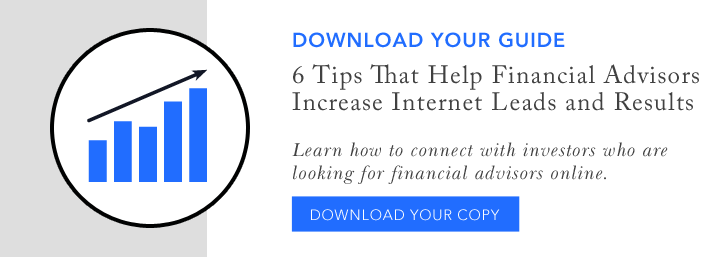RIA Website Study: Inbound Marketing Produces Better Quality Website Visitors
One of the most important tools in marketing for financial advisors is a productive website. RIAs need a website that attracts the right types of visitors and turns them into contacts (someone who submits information through your website). The website and your marketing process should then allow you to nurture that contact into a viable prospect and/or client.
There are several ways investors can find your website:
- Organic traffic: Organic traffic refers to the number of people who find a website on their own – they’re not referred from another site, they weren’t encouraged to click on a link in a social media post and they didn’t find the site from a link in an email. An organic visit happens when someone is simply searching the web for a particular topic and comes across your link in the results. This type of visitors should be a key component of your online marketing strategy.
- Direct traffic: For the most part, direct traffic occurs when a specific URL is typed directly into a browser. Visitors have a particular website address and know where they’re going.
- Referral traffic: Referral traffic refers to the number of visits that come from a secondary site. For example, when someone clicks on a hyperlink and they’re redirected to another URL.
- Social media traffic: Social media traffic is similar to referral traffic, but it only comes from platforms like Facebook, Twitter and LinkedIn.
- Email traffic: Email traffic occurs when someone clicks on a URL in an email. This type of information can determine how successful a specific email marketing campaign was.
- Paid Search traffic: Paid search traffic is reported when a website visit is sparked by a paid ad in a Google search. While this type of traffic can be valuable, it can also be very expensive. As the competition to rank on page 1 of Google intensifies, the cost to ensure a page 1 listing has increased as well.
Because organic traffic is such an important component to driving the right type of qualified visitors to a site, we recently analyzed a number of RIA websites to compare visitor behavior from people who found the site through an organic search. The firms included in the survey have assets under management ranging from $40 million to $3 billion.
We then compared RIA websites that applied inbound-marketing methodologies against websites that are more of the traditional “online brochure” websites with no real inbound-marketing methods applied. We used Google Analytics to track the results.
Here’s what we discovered:
- Inbound sites had a 50% increase in the number of pages viewed per session than non-Inbound sites (1).
- Inbound sites saw a 63% increase of time spent on a website than non-Inbound sites (2).
- Inbound sites experienced a 45% increase of time spent on the home page from non-Inbound sites (3).
- Inbound sites lower bounce rate than non-Inbound sites by 23% (4).
- Inbound sites saw 37% increase of organic visitors than non-Inbound sites (5).

So, how do you determine and track how visitors are finding your site?
Google Analytics and other similar analytical tools will not only help answer the question of whether you have an ineffective website but also offer you tips on what you can do to change that. These tools can show you how visitors are finding your site and then how they are interacting with it. This data can assist you in adapting your design and content to be more interactive with visitors once you know how they are navigating through your site.
The next question to ask is how to attract more qualified organic traffic to your RIA website.
In today’s society, investors aren’t calling a financial professional because of a cold-call they received during dinner or a flashy flyer they received in the mail. Investors are smarter, and they are going to the Internet to find and research advisors themselves before making any kind of appointment.
The first step for an investor is usually Google or another popular search engine. An investor will type in keywords for what they’re looking for, terms like “financial advisor near me” or “financial advisors with good reviews.” If your website appears in the search results, an investor will likely click on your website and start the research process with you.
How do you make that happen? Inbound marketing!
Putting the Two Together: Organic Traffic and Inbound Marketing.
Inbound Marketing is the future of marketing for financial advisors. Instead of wasting time finding clients, inbound marketing is based on the concept that investors will initiate contact with you. You just need to be where they’re looking.
How do you do that?
- Provide content and rank for keywords.
When investors search the Internet, they’re looking for websites that will provide answers to their specific questions. Will you come up in the search results? Do you have regular blog posts that focus on words you believe your clients will be typing into a search engine? If many of your clients are interested in estate planning, do you have content on your site that explains this? Blog posts? EBooks? White pages? When done correctly, this type of content will grab Google’s attention, and therefore, your clients’. But don’t just focus on short keywords that may have a lot of competition. Make your posts specific. Instead of just estate planning, focus on estate planning in your area or on a specific concern within that topic.
- Provide free offers.
If a potential client does find your website and does read a blog post you have about a certain subject, does that piece of content offer a link to free ebook or to a secondary page where they can find out more or contact you for more information. You’ll want to make sure that every offer you have is aimed specifically at the audience you’re trying to reach. The more free offers and the easier it is for leads to find information, the better chance they will begin to trust you as an expert in the field and you will become a place to go for information.
Remember, putting content on the Internet is a long-term investment. Make sure it stays current and up-to-date. The easiest way to lose a lead’s trust is by offering information that no longer exists or is simply wrong.
Creating fresh, relevant content for your website or blog can be a challenge. Say goodbye to writer's block! Download our Free eBook: 5 Ways to Source Content for Your Financial Advisor Blog & Website
We can’t stress enough how important a good, productive website is when it comes to marketing for financial advisors. Start analyzing your site. How is it ranking? Where is your traffic coming from and where can you improve? Small, calculated steps will help you and your business grow over time.


